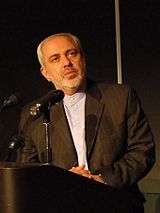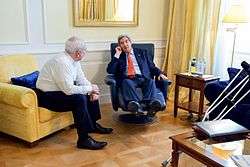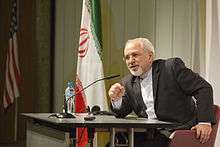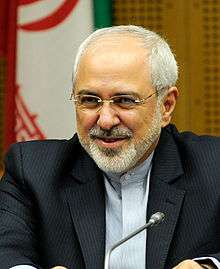Mohammad Javad Zarif
Mohammad Javad Zarif Khonsari (Persian: محمدجواد ظریف خونساری; Persian pronunciation: [mohæmːæd͡ʒːæˌvɒːde zæˌɾiːfe xɒnsɒːˈɾi]; born 7 January 1960) is an Iranian career diplomat,[5] academic and current Minister of Foreign Affairs. He has held various significant diplomatic and cabinet posts since the 1990s. Zarif is also a visiting professor at the School of International Relations and University of Tehran, teaching diplomacy and international organizations. He was the Permanent Representative of Iran to the United Nations from 2002 to 2007.[6]
During his tenure as foreign minister, he led the Iranian negotiation with P5+1 countries which produced the Joint Comprehensive Plan of Action on 14 July 2015,[7] lifting the economic sanctions against Iran on 16 January 2016.[8]
Zarif has held other domestic and international positions as well: adviser and senior adviser to the Foreign Minister, Deputy Foreign Minister in Legal and International affairs, member of the UN Eminent Persons Group on Dialogue Among Civilizations, Head of the UN Disarmament Commission in New York, member of the Eminent Persons Group on global governance, and Vice President for International Affairs of the Islamic Azad University.[9]
Early life and education
Zarif was born on 7 January 1960 in Tehran.[10][11] According to The New Republic, Zarif is born to an "affluent, religiously devout and politically conservative merchant family in Tehran". His father was one of the most well-known businessmen of Isfahan, and his mother was daughter of one of the most famous businessmen of Tehran. He was educated at the Alavi School, a private religious institution.[4]
Zarif was shielded from TV, radio, and newspapers by his parents as a youth. Instead, he became exposed to revolutionary ideas by reading the books of Ali Shariati and Samad Behrangi.[4]
At age 17, he left Iran for the United States. Zarif attended Drew College Preparatory School, a private college-preparatory high school located in San Francisco, California.[4] He went on to study at San Francisco State University, from which he gained a B.A. in 1981 and M.A. in 1982, both in international relations.[12] Following this, Zarif continued his studies at the Josef Korbel School of International Studies, University of Denver, from which he obtained a second M.A. in international relations in 1984 and a Ph.D. in international law and policy in 1988.[13][14] His thesis was entitled, "Self-Defense in International Law and Policy."[15]
Tom Rowe, a professor at the graduate school who led the committee that oversaw Zarif's dissertation, said “He was among the very best students that I've ever taught”.[16] Ved Nanda, who taught and was on Zarif’s dissertation committee, recalled. “[He was] good in the classroom. At that time... I thought he’d play an important part in his country’s life.”[17]
Initial missions in the US
Zarif was appointed a member of the Iranian delegation to the United Nations in May 1982—largely due to his English-speaking ability and relationships in America, rather than formal diplomatic training.[4] As a junior diplomat Zarif was involved in negotiations to win the release of U.S. hostages held by pro-Iranian gunmen in Lebanon, according to the memoirs of former United Nations envoy Giandomenico Picco. Even though the United States did not make a promised reciprocal goodwill gesture at the time, Zarif remained committed to improving ties.[18]
In 2000, Zarif served as chairman of the Asian preparatory meeting of the World Conference on Racism and as the chairman of the United Nations Disarmament Commission. Zarif was also professor of international law at the University of Tehran. He served as the vice president of Islamic Azad University in charge of foreign affairs from 2010 to 2012 under Abdollah Jasbi.[19] He has served on the board of editors of a number of scholarly journals, including the Iranian Journal of International Affairs and Iranian Foreign Policy, and has written extensively on disarmament, human rights, international law, and regional conflicts.[20]
Representative at the United Nations

He served as Iran's representative at the United Nations from 2002 to 2007.[12] He was closely linked with developing the so-called "Grand Bargain," a plan to resolve outstanding issues between the U.S. and Iran in 2003.[21] Zarif, during his time at the UN, held private meetings with a number of Washington politicians, including the then-Senators Joseph Biden and Chuck Hagel.[21] Zarif resigned from office on 6 July 2007.[22] He was succeeded by Mohammad Khazaee in the post.[23]
In 2007, Zarif was a headline speaker at an American Iranian Council conference in New Brunswick, New Jersey including Chuck Hagel, Dennis Kucinich, Nicholas Kristof, and Anders Liden to discuss Iranian-American relations, and potential ways to increase dialogue and avoid conflict.[24]
On 18 November 2008, Zarif claimed that Washington is conspiring to foment discord among Iranians in order to topple the Tehran government. He went on to say:
"The concept of a velvet revolution in Iran should not be considered as groundless fear." [25]
Minister of Foreign Affairs

On 23 July 2013, it was reported that Zarif is Rouhani's choice for minister of foreign affairs. This was not confirmed by the president-elect's office until 4 August when Rouhani officially nominated Zarif for the position to the Parliament.[26] He was confirmed by the Parliament with 232 votes, replacing Ali Akbar Salehi in the position.[27]
He welcomed the first visit by a foreign leader to Iran since Rouhani assumed the presidency ten days after his approval as Foreign Minister with the arrival of Oman's sultan, Qaboos bin Said Al Said. Stories spread that there was a secret agenda to his meetings with Iranian officials, involving claims that he came to convey messages from the United States and then to relay Iran's response to White House officials.[28] On 5 September 2013, having congratulated the Rosh Hashana, Zarif said on Twitter that Iran does not deny the Holocaust, distancing the government from the often belligerent stances by former President Mahmoud Ahmadinejad.[29] Genuineness of Zarif's tweeting in English was confirmed by CNN's Christiane Amanpour.[30] On 27 September 2013, he met with U.S. Secretary of State John Kerry during P5+1 and Iran summit. It was the highest-level direct contact between the United States and Iran in last six years.[31][32] After the meeting, Kerry said that "We had a constructive meeting, and I think all of us were pleased that Foreign Minister Zarif came and made a presentation to us, which was very different in tone and very different in the vision that he held out with respect to possibilities of the future."[33]
After the breakup of talks on 12 November, Zarif rejected John Kerry's claim that Iran had been unable to accept the deal "at that particular moment". He said "no amount of spinning" could change what had happened in Geneva, but it could "further erode confidence". Zarif appeared to blame France for "gutting over half" of a US draft deal. Representatives from Iran and the so-called P5+1 - met again on 20 November.[34]
In October 2014 during talks between senior American, Iranian and European diplomats produced no breakthrough agreement on curbing Iran’s nuclear program, but officials said they still aim to reach a deal by the Nov. 24 deadline. A senior State Department official characterized each step of progress in the talks as "chipping away" at complex, technical differences, with virtually every sentence requiring an appendix of further explanation. "We continue to make progress, but there is still a substantial amount of work to be done," said the official, who spoke on the condition of anonymity to discuss the difficult and secretive negotiations.[35]

Iran and the US will explore ways to give impetus to nuclear talks when their chief diplomats meet in Geneva. Dr Zarif and US secretary of state John Kerry will confer ahead of a fresh round of negotiations between Iran and six world powers on settling their 12-year standoff over Tehran’s nuclear ambitions. Lower-level negotiators on both sides will meet at the same venue on Thursday to iron out technical details ahead of negotiations on 18 January between Iran and the "P5+1" powers – the US, France, Germany, Russia, China and Britain. Speaking at a Tehran news conference, Zarif said the purpose of the talks with Kerry "is to see if we can speed up and push the negotiations forward".[36]
In February 2015 Dr Zarif said that Iran did not favor another extension of the talks on limiting its nuclear program and expected economic sanctions to be quickly lifted if an accord was reached. "Sanctions are a liability; you need to get rid of them if you want a solution," Zarif told a security conference in Munich. "This is the opportunity to do it, and we need to seize this opportunity," he said of the long effort to forge an agreement. "It may not be repeated." The nuclear talks have already been extended twice and face a late March deadline for working out the main outlines of an accord. The deadline for a detailed agreement is the end of June.[37]
Based on the Iran nuclear deal framework, which was declared on 2 April 2015, Iran agreed to accept significant restrictions on its nuclear program for at least a decade and submit to international inspections under a framework deal. In return, international sanctions would be lifted, whether in phases or all at once is still to be worked out.
Nuclear Agreement

On 21 November it was reported by Iranian negotiators that progress was being made in talks in Geneva with world powers, expressing hope to bridge differences and sign an elusive deal over Tehran's nuclear drive. "Differences of opinion remain and we are negotiating over them. God willing we will reach a result," Foreign Minister Mohammad Javad Zarif said in statements carried by Iranian media, after a one-hour meeting with Baroness Ashton.[38] On 24 November 2013, the Geneva interim agreement, officially titled the Joint Plan of Action,[39] was a pact signed between Iran and the P5+1 countries in Geneva, Switzerland. It consists of a short-term freeze of portions of Iran's nuclear program in exchange for decreased economic sanctions on Iran, as the countries work towards a long-term agreement.[7]
- Interview with Charlie Rose
On 29 April 2015, Zarif appearing on the Charlie Rose talk-show, when asked about the detention of Jason Rezaian, the Washington Post reporter held in Iran for the past nine months, claimed: "We do not jail people for their opinions[.]" [40]
Accolades
- 9th Iran National Industry Champions Festival's ‘Champion of Champions of Diplomacy’: 1392 SH[41]
- KhabarOnline's ‘Face of The Year’: 1392 SH[42]
- TIME's ‘100 Most Influential People in the World’ (2): 2014,[43] 2015[44]
- Global Risk Insights' ‘Person of the Year in Political Risk’: 2015[45]
- Chatham House Prize: 2016 (shared with John Kerry)[46]
National orders
-
 Iranian Order of Merit and Management, 1st class: 8 February 2016[47]
Iranian Order of Merit and Management, 1st class: 8 February 2016[47] -
 Bolivian Grand Cross of Order of the Condor of the Andes: 26 August 2016[48]
Bolivian Grand Cross of Order of the Condor of the Andes: 26 August 2016[48]
Public image
Zarif has gained domestic reputation and popularity among people.[49][50] According to a poll conducted by Information and Public Opinion Solutions LLC (iPOS) in March 2016, Zarif is the most popular political figure in Iran with 76% approval and 7% disapproval ratings.[51]
Personal life
Zarif is married and has a daughter and a son who were born in the US.[29] He met his wife in summer 1979 through his sister. They married in Iran but moved to New York within several weeks in the midst of the Iranian revolution.[4] In addition to his native Persian, he is fluent in English.
References
- ↑ "Araghchi appointed as head of 'JCPOA Follow-up Commission'". Mehr News Agency. 22 September 2015. 2922155. Retrieved 15 April 2016.
- ↑ "The Wife of Iran's Foreign Minister Adds a New Twist to the nuclear talks". The Daily Beast. 1 July 2015. Retrieved 15 April 2016.
- ↑ My children resident in Iran Jaam-e Jam
- 1 2 3 4 5 6 Ali Alfoneh and Reuel Marc Gerecht (23 January 2014). "Mohammad-Javad Zarif: Iran's Foreign Minister Is a Religious Zealot". New Republic. Retrieved 28 January 2014.
- ↑ Zarif, Javad (2016-01-14). "Javad Zarif, Author at Harvard International Review". Harvard International Review. Retrieved 2016-01-16.
- ↑ CV Dr. M. Javad Zarif Unesco
- 1 2 Anne Gearan and Joby Warrick (23 November 2013). "World powers reach nuclear deal with Iran to freeze its nuclear program". The Washington Post. Retrieved 24 November 2013.
- ↑ "International sanctions against Iran lifted". Washington Post. 2016-01-16. Retrieved 2016-01-16.
- ↑ Who’s Who in Iranian Politics. Mohammad Javad Zarif Iranian Diplomacy. 13 August 2013
- ↑ Minister's Biography: Mohammad Javad Zarif
- ↑ Kanbiz Foroohar (5 August 2013). "Rohani Taps U.S.-Educated Minister to End Iran Sanctions". Bloomberg. Retrieved 18 August 2013.
- 1 2 Esfendiari, Golnaz (14 August 2013). "Iran's 'Olive Branch' Foreign Minister Nominee Makes His Case In Parliament". Radio Free Europe. Retrieved 15 August 2013.
- ↑ "Iran's Rouhani unveils cabinet of technocrats". The Daily Star. 4 August 2013. Retrieved 7 August 2013.
- ↑ Kirkpatrick, Nick (15 August 2013). "Key figures in the Cabinet of Iran's new president". The Washington Post. AP. Retrieved 22 August 2013.
- ↑ Self-defense in international law and policy WorldCat
- ↑ "Iranian diplomat Zarif made impression at DU". Islamic Republic News Agency. 13 July 2015. Retrieved 15 April 2016.
- ↑ Wright, Robin (26 May 2014). "The Adversary: Is Iran's nuclear negotiator, Javad Zarif, for real?". The New Yorker. Retrieved 15 April 2016.
- ↑ Iran's Foreign Minister Nominee Seen as Olive Branch to US Reuters via VOA (Dubai), 29 July 2013
- ↑ محمد جواد ظریف معاون جاسبي شد Shafaf
- ↑ "Dr. Javad Zarif". UN. Retrieved 2 September 2011.
- 1 2 Rohani Taps U.S.-Educated Minister to End Iran Sanctions Kambiz Foroohar, Bloomberg, 4 August 2013
- ↑ "Welcome to the personal web site of Dr. M. Javad Zarif". Zarif. Retrieved 2 September 2011.
- ↑ "وب سایتهای ایرنا". IRNA. Retrieved 2 September 2011.
- ↑ "Has the U.S. Played a Role in Fomenting Unrest During Iran's Election?". Foreign Policy Journal. 23 June 2009. Retrieved 2 September 2011.
- ↑ http://edition.presstv.ir/detail/75784.html
- ↑ هشت نفر از اعضای کابینه روحانی نهایی شدند +اسامی Iran Elections
- ↑ Kamali Dehghan, Saeed (15 August 2013). "Iran's parliament approves 15 of Hassan Rouhani's 18 cabinet ministers". The Guardian. Retrieved 15 August 2013.
- ↑ Oman sultan's Iran visit sparks hopes of progress in nuclear standoff The Guardian 30 August 2013
- 1 2 Rayman, Noah (5 September 2013). "Iran Doesn't Deny the Holocaust, New Foreign Minister Says on Twitter". Time. Retrieved 6 September 2013.
- ↑ توئیتر منسوب به ظریف: انکارکننده هولوکاست، دیگر رفته است. BBC Persian (in Persian). Retrieved 6 September 2013.
- ↑ Diplomats hail new Iranian attitude in nuke talks
- ↑ U.S., Iran voice optimism and caution after rare encounter
- ↑ Remarks After the P-5+1 Ministerial on Iran
- ↑ Iran blames Western powers for nuclear talks failure BBC. 12 November 2013
- ↑
- ↑
- ↑
- ↑ Iran negotiators see progress in Geneva nuclear talks The Daily Star. 22 November 2013
- ↑ "Iran Strongly Rejects Text of Geneva Agreement Released by White House". Fars News Agency. 26 November 2013. Retrieved 1 December 2013.
- ↑ http://www.theguardian.com/world/2015/may/01/iranian-foreign-minister-angers-supporters-human-rights-charlie-rose
- ↑ "ظریف قهرمان قهرمانان دیپلماسی ایران شد". ٍghtesadOnline (in Persian). 16 January 2014. Retrieved 24 May 2016.
- ↑ "مخاطبان خبر آنلاین در چهار دوره گذشته چه کسانی را به عنوان چهره سال انتخاب کردند؟". KhabarOnline (in Persian). 26 February 2015. Retrieved 24 May 2016.
- ↑ "TIME 100: The Most Influential People in the World in 2014". Time. Retrieved 3 August 2016.
- ↑ "TIME 100: The Most Influential People in the World in 2015". Time. Retrieved 3 August 2016.
- ↑ "GRI's 2015 Person of the Year in Political Risk". Global Risk Insights. 24 December 2015. Retrieved 3 August 2016.
- ↑ "John Kerry and Mohammad Javad Zarif named winners of the Chatham House Prize 2016". Chatham House. 24 October 2016. Retrieved 25 October 2016.
- ↑ "Iran's FM, nuclear chief, DM receive medals for role in nuclear deal". Iranian Students' News Agency. 8 February 2016. Retrieved 15 April 2016.
- ↑ "Iranian FM awarded Bolivia's highest state medal". Islamic Republic News Agency. 26 August 2016. Retrieved 29 August 2016.
- ↑ Karimi, Arash (14 July 2015). "Zarif's domestic popularity soars with nuclear deal". Al-Monitor. Retrieved 1 May 2016.
- ↑ "Zarif; a right man at the right time". The Iran Project. 12 May 2015. Retrieved 1 May 2016.
- ↑ "ظریف محبوبترین چهره سیاسی ایران". Information and Public Opinion Solutions LLC (in Persian). 24 May 2016. Retrieved 24 May 2016.
External links
| Wikimedia Commons has media related to Mohammad Javad Zarif. |
| Wikiquote has quotations related to: Mohammad Javad Zarif |
- Mohammad Javad Zarif on Twitter

- Appearances on C-SPAN
- Mohammad Javad Zarif on Charlie Rose
- Mohammad Javad Zarif at the Internet Movie Database
- Works by or about Mohammad Javad Zarif in libraries (WorldCat catalog)
- Articles
- Statement by H.E. Dr. Zarif before the UN Security Council (31 July 2006)
- H.E. Dr. Zarif speaks at Princeton University (August 2006)
- Article about Zarif's exit from the United Nations in the Washington Post (15 April 2007)
- French article about Zarif and his diplomat life (October 2013)
| Political offices | ||
|---|---|---|
| Preceded by Ali Akbar Salehi |
Minister of Foreign Affairs 2013–present |
Incumbent |
| Diplomatic posts | ||
| Preceded by Hadi Nejad-Hosseinian |
Ambassador to the United Nations 2002–2007 |
Succeeded by Mohammad Khazaee |



